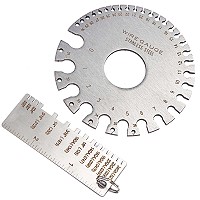The Decibel: AWG Wire Size Rule of Thumb |
|
In 1931, QST reader John H. Miller, Electrical Engineer, of the Jewell Electrical Instrument Company, wrote to the editor regarding the story "What Is This Thing Called Decibel?," by James L McLaughlin and James J. Lamb, which appeared in the August issue of that year. Mr. Miller wished to inform (or remind) readers that the American Wire Gauge system for assigning sizes to wire cross-section ratios closely follows a decibel (i.e., logarithmic) relationship. Applying his information: A 28 AWG solid wire has a cross-section of 160 circular mils, so at 3 sizes larger, 25 AWG should be 320 circular mils. In fact, it is 320 circular mils (see table on the Copper Wire Properties & Gauge Conversions page). A 12 AWG solid wire has a cross-section of 5,630 circular mils, so at 3 sizes larger, 9 AWG should be 13,060 circular mils, and it is 13,090 circular mils. That verifies the 3 dB per three differences in gauge for two cases using small and large wire sizes. What about, say, 5 dB for 5 wires sizes in difference? Using 28 AWG again as a reference, a 5 dB increase in size for 28-5=23 AWG wire should be about 160 * 10^(5/10) = 506 circular mils. The table gives 510 circular mils, which is within cumulative rounding errors in the calculations, so the rule of thumb works for decibel values other than 3. The Decibel: AWG Wire Size Rule of Thumb Editor, QST: I have read with much interest the article in the August issue of QST entitled, "What Is This Thing Called Decibel?" The writer's picture of the decibel may be of some interest, and is based on wire table ratios. The B & S gauge, which is universally used for copper wire, very closely approaches the decibel ratio as regards area or cross section and consequent resistance. A change of ten decibels either multiplies or divides the power by ten, depending whether it is up or down; a decrease of ten sizes in the wire table multiplies the cross section or divides the resistance by ten. An increase of ten sizes does the reverse. A three-decibel change doubles or halves the power, and a change in three sizes of wire doubles or halves the cross section and the resistance changes also by a factor of two. Engineers who are accustomed to working with copper wire have these ratios well in mind, and the fact that the decibel ratio is the same as the wire table cross-section ratio allows a mental picture to be had directly from past experience, and does not require a complete new set of ratios to be memorized. It should be noted that the wire table ratios are not exactly those given, the error being of the order of 3/4 of 1%, which may be entirely neglected when ratios in multiples of unity are considered. - John H. Miller, Electrical Engineer, Jewell Electrical Instrument Co.
Related Pages: RF Cafe Decimal Tutorial
|
The Decibel Without Pain |
Using the Decibel | Decibel Tutorial:
dB and dBm vs. Gain and Milliwatts |
Versatile Voltage, Power, and Decibel Nomograms |
Decibel Level
vs. Decibel Gain |
A Decibel
Nomograph | The Decibel: AWG Wire
Size Rule of Thumb |
What is a Decibel? |
Understanding Decibels |
Decibels Without Logs |
The Useful Decibel | Decibels |
mW-to-dBm / dBm-to-mW Power Conversion |
NEETS: Decibel
Posted September 5, 2022 |
|


